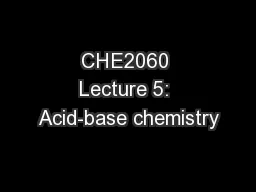

Daley amp Daley Chapter 5 Acidbase theory 51 Acids amp bases overview amp basics 52 Acid amp base strength 53 Equilibrium acidbase reactions 54 The leveling effect of solvents ID: 641144
Download Presentation The PPT/PDF document "CHE2060 Lecture 5: Acid-base chemistry" is the property of its rightful owner. Permission is granted to download and print the materials on this web site for personal, non-commercial use only, and to display it on your personal computer provided you do not modify the materials and that you retain all copyright notices contained in the materials. By downloading content from our website, you accept the terms of this agreement.
Slide1
CHE2060 Lecture 5: Acid-base chemistry
Daley &
Daley
Chapter 5
:Acid-base theory
5.1 Acids & bases: overview & basics
5.2 Acid & base strength
5.3 Equilibrium acid-base reactions
5.4 The leveling effect of solvents
5.5 Estimation of acidity by conceptual knowledge
5.6 Classes of organic acids & bases
5.7 Functional groups: acid-base natureSlide2
The ‘leveling’ effect
Solvents may hijack intended reactionsSlide3
Remember solvents?
Karty
, p.304
Solvents
are compounds that are:Present in large amounts (larger than solvents);Used to create a soluble environment for solute reactants; andSometimes plays a role in solute reactions.
Everyday example
: water is the solvent for extraction of caffeine and other
coffee or tea compounds from beans or leaves.
Ideally
, solvents either have no impact on reactions or actually enhance them.
However
,
if solvents are not selected carefully they can interfere with – or hijack – our intended reactions.Slide4
So, what’s ‘leveling’?
Karty
, p.304
Leveling
is a reaction of the solvent with one of the reactants. This reactionuses up some or most of that reactant and restricts the intended reaction.Acids & bases are often impacted by leveling because they react with a wide variety of solvents, like water
.
pka
~ - 1.7
pka
~ - 7
So
HCl
is a powerful acid
until
it is diluted in water.
Once
HCl
reacts with water, the only acid remaining is hydronium which is 1.99E5 times weaker than
HCl
.
Water ‘levels’ (or reduces or restricts) the strength of
HCl
.Slide5
Base strength can also be leveled by solvents.
Karty
, p.304
Deprotonated dimethyl amine is a base. Note its two free electron pairs.
pKa 38
pKa
15.7
Deprotonated dimethyl amine is a powerful base. Its conjugate acid, dimethyl amine, has a
pKa
of 38!
For bases, the equilibrium is pushed
towards the acid with the higher
pKa
.
The strength of deprotonated dimethyl amine pushes equilibrium towards products by a factor of 2.oE22!
However, if water is used as a solvent when deprotonated dimethyl amine is used as a base, water will act as an acid, react with and ‘neutralize’ the powerful base.
Reaction with the water solvent produces hydroxide as the remaining base.
And hydroxide is a weaker base than deprotonated
dimethylamine
.Slide6
Conclusions about leveling
Karty
, p.304
If
water is used as the solvent, no acid stronger than hydronium, and no base weaker than hydroxide, can exist to appreciable extents. For
other solvents
:
The
strongest acid
that can exist in solution, to appreciable concentrations,
is the protonated solvent
.
The
strongest base
that can exist in solution, to appreciable concentration,
is the deprotonated solvent
.
Take-home message?
Solvents must be chosen carefully!Slide7
Example: wise choice of solvent
Karty
, p.304
If you want to use deprotonated dimethyl amine as a base, diethyl ether is a better solvent than water.
Use
pka
values to show that diethyl ether is a better solvent!
pKa
45
pKa
38
For bases, the equilibrium is pushed towards the acid with the higher
pKa
, so when deprotonated dimethyl amine is placed in diethyl ether solvent the two barely react.Slide8
Example: you choose the solvent!
Karty
, p.304
Would each of these solvents be appropriate for the reactant?
Why?Reactant:
Deprotonated
ethelyne
(acetylene) is a base.
For bases, the equilibrium is pushed towards the acid with the higher
pKa
.
To preserve the ‘baseness’ of the reactant we want to push equilibrium back towards it; to the left.
So use solvents that are
stronger
acids than the conjugate acid of the reactant.
DMSO (
dimethylsulfoxide
) and diethyl ether have higher
pKa
values then acetylene.
Solvents:
pKa
25 for its conjugated acid
pKa
: 15.7 16 17 35 45